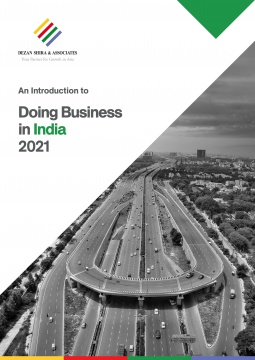
By Chris Devonshire-Ellis
The past week, just before Chinese New Year, Dezan Shira & Associates held a Virtual Partners Meeting to assess the 2020 performance of the firm. As many readers will be aware, we handle foreign direct investment into Asia and have done since 1992. We also have offices throughout the region – we are, in many respects, a bell weather for the status and behavior of FDI into Asia. 2020 was of course in many ways an unusual year, however among many bright spots in the firm’s overall performance was a surprising element – the transactional volume of the foreign investment we handled going into the India market last year doubled. We knew that FDI into the country had been doing well, from the amount of client leads we had been servicing, but the actual dollar value was still a pleasant surprise. India has been badly hit by Covid -19, however is now fast coming out of the pandemic’s worst, and is poised to be a major global contributor to vaccine production on a massive scale.
That improvement in Indian FDI is attributable to many factors, not least the change in attitude to many businesses concerning the China manufacturing market. However, New Delhi has also been busy re-positioning it’s Free Trade and related agreements. For many years, these have been mismanaged and occasionally subverted, with well-meant attempts to boost trade stymied by political factions arguing against this. The stop-start nature of India’s regional agreements, both SAARC and BIMSTEC are primary examples of political meddling interfering with trade.
There are signs that in 2021, this will change. India is far more open and willing than in previous years to engage. This comes after the country pulled out of the RCEP Free Trade Agreement last year, under pressure from the corporate sector about opening markets to China, a powerful RCEP member. Lessons appear to have been learned, although I suspect India plc is still wary of allowing Chinese market access. What has occurred though is a revamping of Trade deals with the ASEAN bloc and the United Kingdom. India already has an FTA with ASEAN and is looking to expand it. This is good news, both for ASEAN based companies looking at India’s 400 million middle class consumer market, and for Indian companies looking at a rapidly expanding 150 million consumer market in ASEAN. India is also fast tracking an FTA with the UK, giving UK companies access to India’s huge market and India access to some of Europe’s wealthiest consumers. My colleague Rohit Kapur in our New Delhi offices expands more upon both of these in this week’s Dezan Shira & Associates Partners Editorial.
However, it appears that much more could be on the way. India is currently negotiating an FTA with the Russian-lead Eurasian Economic Union. With links to Russia via the International North-South Transportation Corridor (INSTC) this gives both countries access to relatively virgin, unexplored markets. It offers a route to Europe for India, and brings Iran, which until 1947 had a border with India, once again into the direct Indian trade sphere.
India has also recently upgraded the terms of its FTA with South America’s Mercosur trade bloc, in its own right one of the largest in the world, and has FTA or preferential trade agreements pending with an astonishing number of countries, including Colombia, Ecuador, Peru, Uruguay, and Venezuela in Latin America, the Middle East’s Gulf Cooperation Council (Bahrain, Kuwait, Oman, Saudi Arabia, Qatar and the UAE), the Southern African Customs Union (Botswana, Lesotho, Swaziland, South Africa), Australia, New Zealand, Egypt, Israel, Georgia, Turkey, Iran, Bangladesh, China, Taiwan, Indonesia, and the Philippines. This is quite apart from its existing FTA with countries such as Japan, Malaysia, Singapore, and South Korea, among others. Clearly, 2021 is going to be a busy year for India’s lead trade negotiators.
This is good news for foreign investors, as it means access to a far larger variety of products that can be brought into one of India’s numerous Free Trade Zones, finished, and either sold onto the domestic market, shipped overseas, or both. With India poised to become the single largest source of Covid-19 vaccines, the timing could not be more apt.
In this week’s Asia Briefing then our Special Feature is about India Manufacturing Opportunities and we shall be running related pieces on developments in some of its neighboring countries, such as Sri Lanka, Bangladesh, and Nepal as well as Iran.
Our 2021 Doing Business In India Guide can be accessed, free of charge below.

An Introduction to Doing Business in India 2021
Stay safe!
Best regards;

Chris Devonshire-Ellis
Chairman, Dezan Shira & Associates
Publisher, Asia Briefing
E: editor@asiabriefing.com
W: www.dezshira.com
Disclaimer
Any views or opinions represented in this blog are personal commentary, belong solely to the contributor and do not necessarily represent the views of Asia Briefing Limited or Dezan Shira & Associates.


